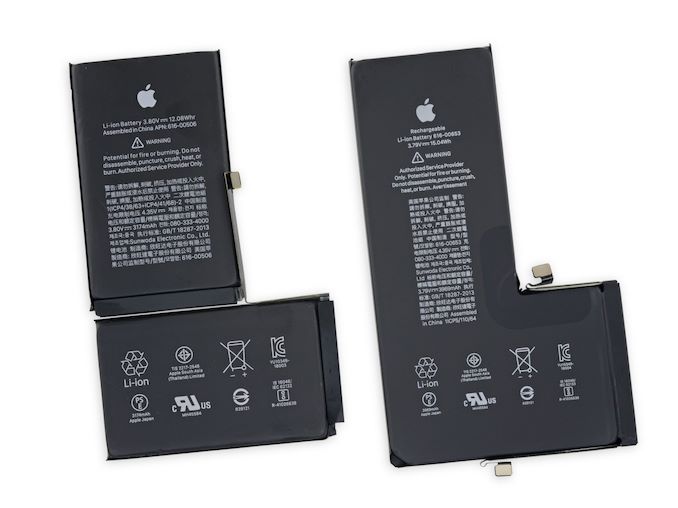The Apple iPhone 11, 11 Pro & 11 Pro Max Review: Performance, Battery, & Camera Elevated
by Andrei Frumusanu on October 16, 2019 8:30 AM ESTBattery Life - A Magnitude Shift
By now many will have heard positive things about the new iPhone 11s' battery life. As we have covered in the introduction, possibly the biggest changes to Apple’s line-up this year is the device’s vastly increased battery capacities. The Pro models in particular have seen significant increases: the 11 Pro gets a 3046mAh battery which represents a 14.5% increase compared to the XS, and the 11 Pro Max gets a 3969mAh battery which represents a very large 25% increase. The Pro Max is now the first Apple device which has a battery capacity comparable to Android phones out there, some of which have offered similar large capacities for a few years now.

iPhone XS Max vs. iPhone 11 Pro Max Batteries (Image Courtesy iFixit)
The regular iPhone 11 sees only a 5.7% bump to up to 3110mAh, which isn’t all that big upgrade compared to the XR. But it also doesn’t increase its weight nearly as much as the Pro models.

The battery results in our web test are outstanding. Apple in this generation has gone from being average in battery life to showcasing some of the best results we’ve seen in the market.
What is very interesting here is how our absolute test runtimes end up compared to Apple’s marketing claims. Apple has promised +1H, +4H and +5H of battery life for the 11, 11 Pro and the 11 Pro Max compared to their predecessors, and what we measured is 1.08H, 3.9H and 5.27H, which is pretty damn near Apple’s promoted figures, pointing out to some very similar testing conditions between our test and Apple’s internal metrics.
If we break this down a bit and theorize a bit, if we take the XS Max 10.31H result, multiply by 1.25x for the increased battery capacity (12.88H), multiply again naively by 1.15x for the more efficient screen (14.82H), we’re left with a ~5% margin which would account for the more efficient SoC. Give or take margin of error here or there, the results we’re seeing shouldn’t be all too surprising. The math would also check out for the iPhone 11 without a newer display: 5% increased battery capacity and an on average ~3% more efficient SoC.
There’s not much to say about the new iPhone 11 series' battery life other than it's exemplary. More importantly, Apple has managed to finally catch up and exceed the battery life of the LCD iPhone 8 and Plus models from 2 years ago.










242 Comments
View All Comments
joms_us - Wednesday, October 16, 2019 - link
Try 4.4Ghz Core2Duo E8600 and Ryzen 3600x in SuperPI 1M.You will see E8600 is faster by 2 secs, makes you wonder?
Released in 1995, 13-15 years difference between two processors. E8600 is faster? LOL
This SPEC need serious overhauling, same as GB that is tuned to Apple SoC. Apple A13 faster than 5GHZ Intel or Ryzen in GB5? LOL, people are seriously retarded nowadays...
thunng8 - Wednesday, October 16, 2019 - link
What has superPI got to do with spec2006? Spec2006 is a well respected desktop/workstation benchmark that tests many different algirthms and use case while superPI does 1 specific narrow test.As a real world example, I've found my ipad pro 2018 exports RAW files from Adobe lightroom faster than my 2018 6 core mac mini (i7-8700) and a lot faster than my 2017 13" (2xi5) macbook pro (almost 2x faster).
Laptopmag also had similar findings. https://www.laptopmag.com/reviews/laptops/new-ipad...
Quantumz0d - Thursday, October 17, 2019 - link
Do you know that Apple pays Adobe for First Party Optimization ? GB also is not an indicative performance.thunng8 - Thursday, October 17, 2019 - link
So Adobe Lightroom is optimized for Apple and not their largest platform and money earner which has lots of competitors? That’s the silliest comment I’ve seen yet.WinterCharm - Thursday, October 17, 2019 - link
People aren’t ready to believe it because of their PC / X86 bias.The writing is on the wall. Objective measurements show that Arm has caught up, and half the people in these comments are making excuses or saying “nuh uh because it doesn’t run Linux”
id4andrei - Thursday, October 17, 2019 - link
Hey joms, spec is an efficiency benchmark. A 5w CPU does not beat an actively cooled 65w one from AMD or Intel. At least in SPECint Apple matches desktop CPUs. That's how you interpret.Give credit to Apple and move on.
joms_us - Thursday, October 17, 2019 - link
Problem is, graph is a huge mess, not normalized. For e.g A13 maybe doing 60+ in perf but consuming 5w whereas SD850 is doing 30 perf in a mere 2w. Which one is better?id4andrei - Thursday, October 17, 2019 - link
From an overall performance standpoint obviously A13. From an efficiency standpoint the 855 equalled the A12. Both are slightly more efficient than A13 from a peak power perspective. In real life, with average workloads, A13 is overall more efficient than both.Apple invests a lot in their chips and sets the pace. Come February next year it's up to Qualcomm to narrow the gap.
joms_us - Thursday, October 17, 2019 - link
There you go, efficiency is the key and A13 is not as efficient as you said. Now in realworld comparison, the likes of Note 10 and OP7T are far better and or bang for the buck. Those long perf graphs are really misleading.. time to fix them.id4andrei - Friday, October 18, 2019 - link
I'm an android user and nothing here is misleading. The A13 is the best SoC.One thing to understand is that the iphone here is deliberately actively cooled so that it removes all thermal restraints and show the chip's full capabilities. In real life it would throttle.